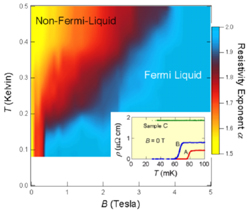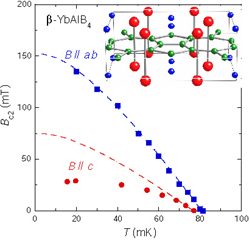Quantum Criticality and Superconductivity
in the New Heavy Fermion System β-YbAlB4
Nakatsuji, Sakakibara, and Ishimoto Groups
A challenge for the standard model known as Fermi liquid theory is anomalous (non-Fermi-liquid) properties of metals and still rare but increasing number of unconventional superconductivity, both of which are often found in the vicinity of the quantum critical point, where a magnetic ordering temperature is driven to absolute zero by tuning a physical control parameter. These nontrivial collective phenomena are subtle and highly sensitive to sample purity and homogeneity of the environment, and thus the study of highly clean system under ambient conditions is ideal. For the study of such exotic phenomena, heavy-electron metals of 4f intermetallic compounds have provided prototype materials. An important issue concerning 4f intermetallics is the possibility of the parallelism between the physical properties of electron-like (4f 1 Ce) and hole-like (4f 13 Yb) compounds. The study of Ce and Yb materials indeed finds many similarities deriving from the antiferromagnetic coupling between the 4f magnetic moments and the conduction electrons (the Kondo screening) which leads to highly enhanced electronic effective masses at low temperatures. There has been however, a remarkable difference among their superconducting properties. While a number of Ce-based unconventional superconductors is found in the vicinity of a quantum critical point, in Yb-based heavy fermion compounds superconductivity has never been reported.

Fig.1. Contour plot of the resistivity exponent α defined by Δ ρ= (ρ(T )-ρ(0)) ∼ T α in the temperature-field phase diagram [2]. Inset: Zero-field in-plane resistivity ρ ab vs. T for various single crystals with different qualities, showing high sensitivity of T c to sample purity. This indicates strong pair-breaking effects due to impurities, probably of nonmagnetic type, and suggests an unconventional character of the superconductivity [3].

Fig. 2. Temperature dependence of the upper critical field B c2 along the ab-plane (square, blue) and the c-axis (circle, red)[3]. Different single crystals with similar T c were used for each field direction measurement. Broken lines represent the curves obtained by fitting to the experimental results near Tc using the WHH model. Inset, the crystallographic unit cell of α-YbAlB4 [1].
Recently, we have succeeded in synthesizing a new structural form of YbAlB4, β-YbAlB4 [1]. Our detailed work on the low temperature transport and thermodynamic properties of β-YbAlB4 has revealed that this material is a rare example of a highly clean metal that displays quantum critical behavior at ambient pressure and under no applied magnetic fields [2]. Furthermore, we have discovered superconductivity in the quantum critical regime characterized by pronounced non-Fermi-liquid response [2,3].
The superconductivity is observed below Tc =80 mK (Fig. 1). Interestingly, the system exhibits pronounced non-Fermi-liquid behavior above Tc, which is characterized by T 1.5 dependence of the resistivity (Fig. 1), T -1/3 dependence of the susceptibility and logarithmic divergent electronic specific heat coefficient [2]. Furthermore, the magnetic field dependence of the non-Fermi-liquid behavior in Fig. 1 indicates that β-YbAlB4 is a rare example of a pure metal that is quantum critical without tuning any physical parameter, i.e. without doping, applied pressure and magnetic field [2]. Our study using high-purity single crystals indicates that the superconductivity is in the clean limit and most likely involves heavy quasi-particles [3]. Upper critical fields are anisotropic, and strongly suppressed for the field along the c-axis, possibly because of the paramagnetic effect due to the divergent c-axis susceptibility (Fig. 2). Strong sensitivity of Tc to sample purity suggests that the superconductivity is of an unconventional, non-s-wave type (Fig. 1 inset).
References
- R. T. Macaluso, S. Nakatsuji, K. Kuga, E. L. Thomas, Y. Machida, Y. Maeno, Z. Fisk, and J. Y. Chan, Chem. Mater. 19, 1918 (2007).
- S. Nakatsuji, K. Kuga, Y. Machida, T. Tayama, T. Sakakibara, Y. Karaki, H. Ishimoto, S. Yonezawa, Y. Maeno, E. Pearson, G. G. Lonzarich, L. Balicas, H. Lee, and Z. Fisk, Nature Phys. 4, 603 (2008).
- K. Kuga, Y. Karaki, Y. Matsumoto, Y. Machida, and S. Nakatsuji, Phys. Rev. Lett. 101, 137004 (2008).
